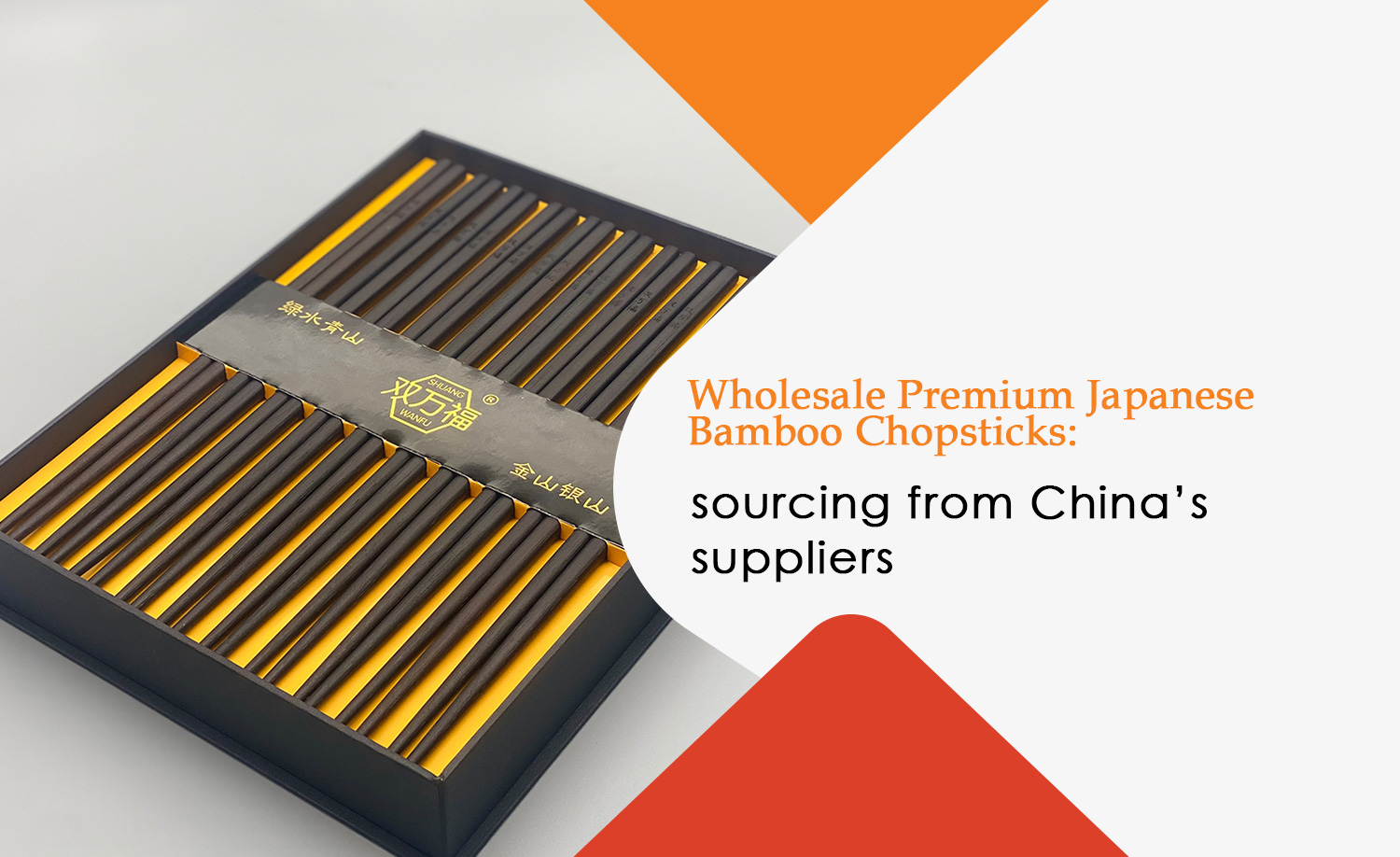Chopsticks are one of the most universally admired and culturally significant dining tools. Bamboo chopsticks are unique among the many types of chopsticks available because of its longevity, eco-friendliness, and classic style. Purchasing from China’s wholesale providers offers a special chance for individuals looking for high-quality bamboo chopsticks in the Japanese style.
It’s interesting to note that, despite the well-known quality of Japanese chopstick craftsmanship, a large number of Chinese producers are currently meeting the rising demand for premium bamboo chopsticks with Japanese design inspiration. These vendors give companies the opportunity to stock high-end chopsticks without sacrificing quality by fusing cost-effectiveness with cutting-edge manufacturing techniques.
The market for bamboo chopsticks will be examined in this article, along with the benefits of sourcing from China and the salient features of premium Japanese bamboo chopsticks at wholesale prices.
Japanese Bamboo Chopsticks’ Allure
Bamboo chopsticks made in the Japanese way are more than simply practical tools; they are a representation of sustainability, workmanship, and heritage. This is the reason they are so well-liked:
- Sustainable Materials
One of the world’s most sustainable materials is bamboo. Bamboo is a sustainable material that grows quickly, making it an eco-friendly option for chopsticks. In instance, raw bamboo is frequently used to make Japanese-style bamboo chopsticks, which guarantees that they are chemical-free and biodegradable. - Stylish Style
Bamboo chopsticks from Japan are renowned for their simple yet practical designs. These chopsticks radiate sophistication and elegance with their tapered tips, smooth surfaces, and classic embellishments like engraved designs or lacquered coatings. - Adaptability
Japanese bamboo chopsticks are appropriate for ceremonial use as well as daily dining. They are perfect for both adults and kids because they are lightweight, manageable, and come in a variety of sizes. - Sturdiness
Bamboo chopsticks are lightweight, but with the right care, they are strong and durable. They are a sensible and dependable option for homes, restaurants, and gift sets because of their durability.
Why Purchase Bamboo Chopsticks in the Japanese Style from China?
Although Japan is renowned for its chopstick tradition, China has emerged as a major provider of bamboo chopsticks in the Japanese style for a number of reasons:
- Economicalness
Suppliers are able to make high-quality bamboo chopsticks at cheap prices thanks to China’s extensive manufacturing capabilities. Businesses can buy in bulk and keep strong profit margins more easily as a result. - Superior Craftsmanship
Replicating the fine craftsmanship of traditional Japanese chopsticks is a speciality of many Chinese providers. These suppliers create chopsticks with etched patterns and lacquered finishes that satisfy international quality standards. - An extensive array of choices
Chinese vendors provide a wide range of bamboo chopsticks in the Japanese style to suit various tastes and requirements. There are options in a variety of patterns, sizes, and finishes, whether you’re searching for reusable sets for gift-giving or disposable chopsticks for restaurants. - Personalisation and Labelling
OEM (Original Equipment Manufacturer) and customisation services are offered by numerous Chinese firms. This enables companies to purchase chopsticks with distinctive designs, packaging, or custom branding that are suited to their target audiences. - Effective Logistics and Shipping
The efficient processing and delivery of wholesale orders is guaranteed by China’s established logistics network. In order to promote seamless international trade, suppliers frequently collaborate with multinational shipping firms.
Japanese Bamboo Chopstick Types That Are Wholesalely Available
When purchasing high-quality Japanese-style bamboo chopsticks from China, consumers have a number of options to pick from:
Uses for Disposable Bamboo Chopsticks: These are perfect for events, restaurants, and takeout services.
Features include being lightweight, biodegradable, and individually packaged for hygienic reasons.
Popular Styles: One popular kind of disposable chopsticks is waribashi, or split chopsticks.
- Reusable Bamboo Chopsticks: Ideal for gift-giving, fine meals, and homes.
Features: Sturdy, frequently coated or lacquered for increased durability and visual appeal.
Popular styles include simple, polished bamboo designs or lacquered chopsticks with traditional Japanese motifs. - Gift Set Uses: Expensive chopstick sets are well-liked presents for corporate gatherings, anniversaries, and weddings.
Features: Frequently presented in tasteful paper or wooden boxes with hand-painted or engraved decorations.
Sets with matching spoons or chopstick rests are popular styles. - Uses of Kids’ Bamboo Chopsticks: Made for younger users who are just learning how to use chopsticks.
Features include colourful designs, smaller sizes, and occasionally training aids like finger rings.
How to Pick the Best Chinese Supplier
When looking for wholesale Japanese bamboo chopsticks, it’s important to find a trustworthy supplier. The following advice will help you choose the ideal partner: - Examine the credentials of the supplier
Search for vendors on reliable websites like Global Sources, Made-in-China, or Alibaba.
Look for vetted vendors who have a solid exporting history to foreign markets and good reviews. - Make a Sample Request
To evaluate the bamboo’s quality, craftsmanship, and finish, always ask for samples. This is particularly crucial for high-end chopsticks. - Verify Certifications
Verify that the supplier complies with safety and quality requirements, such as ISO certification for bamboo sourcing and FDA permission for food-grade components. - Discuss and agree upon minimum order quantities (MOQs).
Verify the supplier’s minimum order quantity and make sure it fits your company’s requirements. For first-time customers, some providers are open to taking lesser purchases. - Evaluate Your Customisation Choices
Make sure the supplier provides OEM or private label services if you require branded packaging or distinctive designs.
Current Market Trends for Bamboo Chopsticks
The bamboo chopsticks market is still developing, and customer tastes are being shaped by a number of trends: - Green Products
Customers are choosing reusable and biodegradable chopsticks as a result of increased environmental consciousness. In response, suppliers are providing sustainable packaging and unprocessed bamboo choices. - Designs that are minimalist
There is a great need for elegant, simple designs that draw inspiration from Japanese aesthetics. Particularly well-liked are delicate patterns, natural bamboo textures, and lacquered finishes. - High-end gift sets
Expensive chopstick sets in upscale packaging are increasingly popular as presents. These frequently consist of extras like spoons, chopstick rests, or placemats that match. - Personalised Branding
Custom chopsticks are becoming more and more popular among businesses, particularly restaurants and event planners, for branding purposes.
In conclusion, Premium A classic item that blends practicality, ecology, and cultural value are Japanese bamboo chopsticks. Businesses may obtain premium goods at affordable costs and take advantage of a large range of patterns and personalisation choices by purchasing these chopsticks from China’s wholesale vendors.
Working with a reputable Chinese supplier will help you satisfy the rising need for stylish and environmentally friendly chopsticks, whether you’re a distributor, restaurant owner, or store. You may appeal to customers searching for eco-friendly dining options and introduce the elegance of Japanese-style bamboo chopsticks to your market with the correct strategy.

